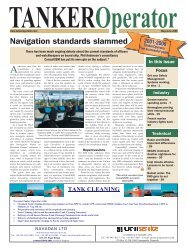Download - Tanker Operator
Download - Tanker Operator
Download - Tanker Operator
You also want an ePaper? Increase the reach of your titles
YUMPU automatically turns print PDFs into web optimized ePapers that Google loves.
TECHNOLOGY - TANK GAUGING<br />
Vessels benefit from<br />
intelligent sensors<br />
As elsewhere in life the move to digital technology is evident in many aspects<br />
of ship operation today, but one area that has been slow to take the step forward<br />
is tank gauging and data acquisition systems*.<br />
From a cost perspective the<br />
predominant technology employed<br />
for level measurement of ballast,<br />
service, and bunker tanks is still the<br />
hydrostatic head or pressure principle. The<br />
most basic of this technology is the direct<br />
“bubbler” or air reactive gauge but since on<br />
most modern vessels it is essential that data is<br />
in electronic format the direct electronic<br />
sensor with a 4-20mA analogue signal is<br />
probably the most cost effective and certainly<br />
the most flexible to install.<br />
The past argument that a directly installed<br />
sensor could be less reliable is certainly not<br />
true today. Mechanically, many quality marine<br />
sensors have been specifically developed to<br />
withstand the rigours and corrosive aspects of<br />
these applications. Electrically, too, correct<br />
design considerations ensure their<br />
performance and reliability is not<br />
compromised by thermal and other adverse<br />
affects imparted by the duty.<br />
Meeting all the above criteria and ensuring<br />
compliance with intrinsic safety parameters<br />
has in the past only been practical using<br />
analogue electronic circuits and clearly<br />
millions of such sensors have been installed<br />
on board ships of all type. That all sounds<br />
well and good - however, that is where the<br />
development has remained for many years<br />
now and as with most things in life and at sea,<br />
there is an increasing downside.<br />
In a conventional arrangement each<br />
transmitter requires its own cabling which<br />
runs from the point of measurement to the<br />
point of display. Some systems have adopted<br />
marshalling arrangements where sensor<br />
cabling is routed to one or more instrument<br />
cabinets, which convert the 4-20mA signal to<br />
a digital format for onward transmission, but<br />
these provide only a half-way solution and<br />
conversion errors compromise on the accuracy<br />
of the overall measurement. The downside is<br />
that although the cost of sensors has gradually<br />
reduced as demand increases, there is a<br />
greatly increased cost of cable and skilled<br />
labour to install and commission these<br />
systems. In many larger systems the cost of<br />
installation can exceed the cost of the system<br />
components.<br />
PSM has designed and manufactured<br />
electronic marine and naval sensors for over<br />
30 years and has continuous experience of<br />
supplying sensors to these applications, both<br />
directly and, through a number of specialist<br />
system integrators.<br />
Having now undertaken more than two<br />
years of shipboard trials on board both Royal<br />
Navy platforms and commercial vessels, the<br />
company confidently releasing ther Intelligent<br />
Ceramic Transmitter (iCT) and associated<br />
system products. The iCT is type approved<br />
and ATEX certified and for the first time<br />
enables the full implementation of a digital<br />
tank gauging system. It is arguably the most<br />
advanced sensor system available for the task<br />
and when one reviews advantages and<br />
features, it is clear to see there should be<br />
significant benefits to be derived by all parties<br />
- eg the shipyard, system installer and the<br />
operator. For cabling, PSM calculated that<br />
over 70% of the cost of cable and installation<br />
components (cable trays, trunking, JBs,<br />
penetrators etc) can be saved on an average<br />
system.<br />
In detail, the iCT measures tank level<br />
hydrostatically using an ultra stable ceramic<br />
capacitance cell. It contains an embedded<br />
microprocessor that processes the level<br />
measurement locally to provide a direct digital<br />
output. The output format employs industry<br />
standard MODBUS protocol for universal<br />
compatibility transmitting onto a robust and<br />
proven RS485 standard.<br />
January/February 2010 TANKER<strong>Operator</strong> 41

















